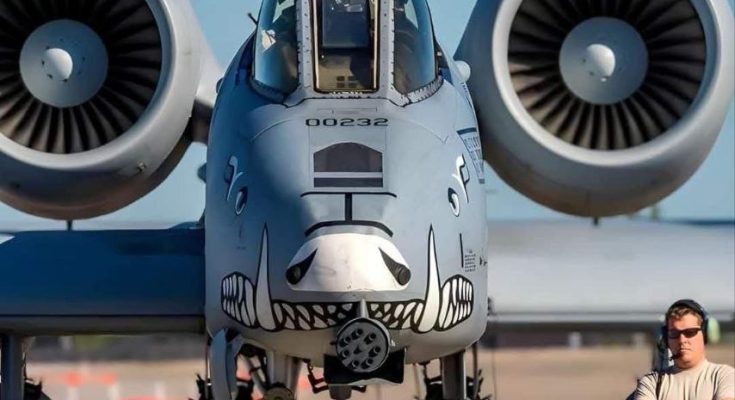The A-10 Thunderbolt II, also known as the “Warthog,” is one of the most recognizable and enduring aircraft in the United States Air Force (USAF) arsenal. Known for its durability, firepower, and exceptional capabilities in close air support (CAS), the A-10 has proven to be a critical asset on the battlefield. One particular mission stands out, highlighting the incredible skill and bravery of the A-10 pilot who executed an inspiring close air support mission under intense conditions, demonstrating the true potential of this legendary aircraft.
The Role of Close Air Support
Close air support is one of the most critical and high-stakes roles in modern combat, where aircraft provide direct support to ground forces engaged in battle. The A-10 Thunderbolt II is specifically designed for this role, with a heavy emphasis on low-altitude, slow-speed operations and the ability to provide sustained firepower on enemy targets near friendly troops. This makes the A-10 a favorite among ground forces, who rely on the aircraft’s ability to deliver precision fire and heavy ordinance while minimizing collateral damage.
Equipped with the iconic GAU-8/A Avenger 30mm cannon, the A-10 can unleash devastating firepower on targets with incredible accuracy. Additionally, the aircraft is designed to be extremely rugged and able to withstand significant damage, ensuring it can continue flying even after taking hits from enemy fire. This resilience and firepower make the A-10 a formidable force on the battlefield, providing unparalleled support to soldiers and Marines in the most dangerous environments.
Mission Briefing
On a particular mission, an A-10 pilot was tasked with providing close air support for a ground unit that had become engaged in heavy combat with a well-equipped enemy force. The terrain was rugged, and the enemy forces were entrenched in fortified positions, making the situation increasingly dire for the ground troops. The mission was critical, as the soldiers needed immediate air support to break the stalemate and push back the enemy.
The pilot received the call for support while airborne, with the intensity of the battlefield clear in the radio chatter. The A-10 pilot immediately reconfigured the aircraft for a precision strike, selecting a mix of precision-guided munitions (PGMs) and the cannon to neutralize enemy targets.
Execution of the Mission
As the A-10 Thunderbolt II descended toward the battlefield, the pilot used the aircraft’s advanced targeting systems to lock onto enemy positions. With the familiar thunderous roar of the GAU-8 cannon, the pilot unleashed a barrage of 30mm rounds, hammering enemy positions with pinpoint accuracy. The A-10’s low and slow flight profile allowed the pilot to make multiple passes, ensuring that each target was thoroughly engaged.
The ground forces were able to relay real-time information about the enemy’s movements and positions, which the pilot used to adjust their strikes and provide even more effective support. The A-10’s ability to loiter over the battlefield for extended periods allowed the pilot to provide continuous coverage and respond to evolving threats. The intensity of the mission only grew as enemy fire intensified, but the A-10’s robust design and the pilot’s unwavering focus kept the aircraft on target.
In one particularly harrowing moment, the pilot spotted an enemy anti-aircraft position threatening the success of the mission. With precision and courage, the pilot maneuvered the A-10 into range and engaged the target with the GAU-8 cannon, silencing the threat and ensuring that the ground unit would have the air superiority they needed to push forward.
An Inspiring Display of Courage
What made this mission truly inspiring was the pilot’s unrelenting focus and courage under fire. The A-10 Thunderbolt II was built for these kinds of operations, but it is the pilot’s skill, resolve, and bravery that make such missions successful. The coordination with ground forces, quick decision-making, and the ability to adapt to rapidly changing conditions in the heat of battle demonstrate the true essence of what close air support means in modern warfare.
By the end of the mission, the ground forces had successfully pushed back the enemy, securing their position and accomplishing their objective. The pilot’s exceptional flying and tactical expertise played a crucial role in this success. The A-10 Thunderbolt II, with its devastating firepower and rugged durability, proved once again that it remains one of the most valuable assets in the USAF’s arsenal.
Conclusion: A Legacy of Excellence
The inspiring close air support mission executed by the A-10 pilot showcases not only the capabilities of the A-10 Thunderbolt II but also the exceptional training, skill, and courage of the men and women in the United States Air Force. As long as the A-10 remains in service, it will continue to be a symbol of airpower and precision on the battlefield, providing critical support to ground forces and ensuring the success of complex military operations. This mission, like many before it, highlights the incredible partnership between air and ground forces, ensuring that the U.S. military maintains a decisive advantage in modern warfare.



